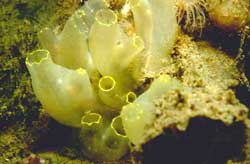Search Results for: ocean
Scientists discover global warming linked to increase in tropopause height over past two decades
Researchers at the Lawrence Livermore National Laboratory have discovered another fingerprint of human effects on global climate.
Recent research has shown that increases in the height of the tropopause over the past two decades are directly linked to ozone depletion and increased greenhouse gases.
The tropopause is the transition zone between the lowest layer of the atmosphere — the turbulently-mixed troposphere — and the more stable stratosphere. The tropopause lies rough
Research finds life 1000 feet beneath ocean floor
A new study has discovered an abundance of microbial life deep beneath the ocean floor in ancient basalt that forms part of the Earth’s crust, in research that once more expands the realm of seemingly hostile or remote environments in which living organisms can apparently thrive.
The research was done off the coast of Oregon near a sea-floor spreading center on the Juan de Fuca Ridge, by scientists from Oregon State University and several other institutions. It will be published Friday
Hitchhiking rocks provide details of glacial melting in West Antarctic
Rocks deposited by glaciers on mountain ranges in West Antarctica have given scientists the most direct evidence yet that parts of the ice sheet are on a long-term, natural trajectory of melting.
The West Antarctic Ice Sheet has been melting and contributing water continuously to the ocean for the last 10,000 years and is likely to keep doing so, says John Stone, University of Washington associate professor of Earth and space sciences.
Measuring and understanding changes in the Eart
A drop of ocean water tells a story
Scientists are still learning what’s in a drop of ocean water, according to this week’s Nature Magazine. And the answers have implications for the whole planet, says co-author Craig Carlson, an oceanographer at the University of California, Santa Barbara. Carlson is an assistant professor in the Department of Ecology, Evolution and Marine Biology.
About ten thousand bacterioplankton of the type SAR 11 are found in every drop of seawater. And yet, as explained in the article, which
Livermore researchers determine biosphere unaffected by geoengineering schemes
Using models that simulate the interaction between global climate and land ecosystems, atmospheric scientists from the Lawrence Livermore National Laboratory have shown that compensating for the carbon dioxide “greenhouse effect” by decreasing the amount of sunlight reaching the planet (geoengineering) could create a more vigorous ecosystem while helping to curb global warming.
The study suggests that planetary-scale engineering projects to lessen the amount of solar radiation reaching the

Sea squirt DNA sheds light on vertebrate evolution
Genome of Ciona intestinalis yields new insights into the origins of complex biological systems
The streamlined genome of Ciona intestinalis, a common sea squirt closely related to vertebrates on the evolutionary tree, is providing new clues about the origins of key vertebrate systems and structures including the human hormone, nervous and immune systems.
In an article for the December 13, 2002 issue of the journal Science, an international consortium of researchers reports